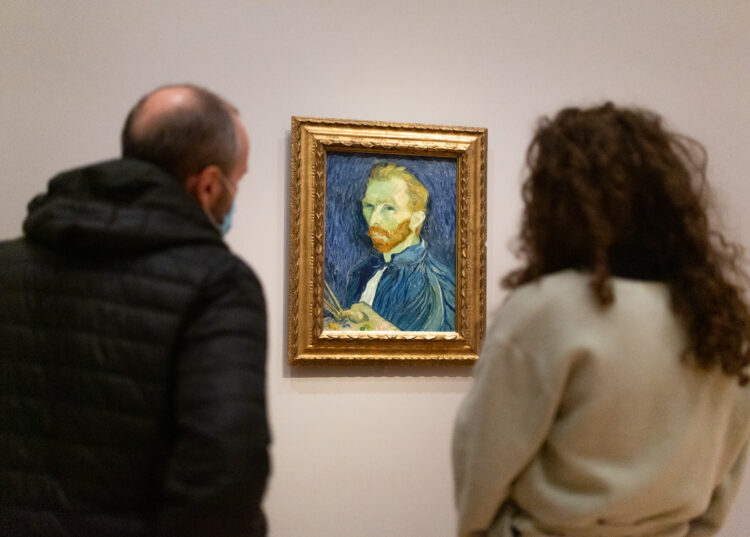Opening on Feb. 3, The Courtauld Gallery will launch the first ever exhibition of Vincent van Gogh’s self portraits that spans his entire career. Two of the works, both painted in Saint Paul de Mausole asylum just weeks apart, will be reunited for the first time in 130 years.
During a span of three and a half years at the end of his life, Van Gogh created countless self-portraits, of which 35 paintings and two drawings survive. The exhibition at The Courtauld gallery displays 16 of these representations
According to the exhibition curator, Karen Serres, the variety of the portraiture presents the unique opportunity to glimpse Van Gogh’s creative and personal growth.
“Van Gogh is an icon of self-portraiture,” Serres said. “His self-portraits have come to define him in the public imagination, offering access to his personality and becoming the lens through which we view his genius, passion, resilience, and struggles.”
But why did Van Gogh paint so many self-portraits before his death? The three and a half years between spring 1886 and September 1889 were a turbulent and revolutionary time in Van Gogh’s life, marked by his arrival in Paris, the mutilation of his own ear, exposure to new vibrant art styles, and stays in two different psychiatric hospitals.
At the time he arrived in Paris, avant-garde artists like Gauguin and Cezanne frequently produced self-portraits. For Van Gogh, self-portraits were an accessible way to experiment with the new styles he saw in Paris. He didn’t need to pay for a model; all he needed was an easel and a mirror.
His earliest self-portrait in the exhibition, “Self-Portrait with Felt Hat,” reflects the darker colours that characterise his work in the Netherlands. But as time passed, Van Gogh’s portraits brightened in palette and shifted in style, inspired by Impressionist artists like Monet and Seurat. The introduction of his classic yellow straw hat and blue painter’s smock in 1887, combined with the enhanced confidence of his brush strokes, marked a period of growth for the artist. Van Gogh left Paris in February 1888 after completing the work, “Self-Portrait as a Painter” that displayed the culmination of everything he had learned during his time.
Head of The Courtauld Gallery Ernst Vegelin van Claerbergen reflected on the significance of being able to watch Van Gogh progress through his work during this time.
“I just think that having them all together is just a fantastic opportunity to see how he develops in those three and a half years, with his style and his ambition as a painter. It’s a sort of map that shows his own story, his own biography. In some cases, it’s really sort of powerful and poignant because you are looking into the artist’s eyes in a sense,” Vegelin van Claerbergen said.
After two years in Paris, Van Gogh moved to Arles, a small town by the River Rhone, and was able to use the techniques he had learned to develop his independant and signature style. Fellow artist, Paul Gaugin, stayed with Van Gogh during this time, but the friendship ended with an argument that drove Van Gogh to cut off his ear.
Van Gogh completed “Self-Portrait with Bandaged Ear” a week after being discharged from the hospital following his ear mutilation in January 1889. Head of The Courtauld Gallery Ernst Vegelin van Claerbergen shared that he was particularly attached to this self-portrait that has permanent residence at the Courtauld.
“The Bandaged Ear is such a powerful work” Vegelin van Claerbergen said. “It’s him sort of in a very unflinching way sort of addressing himself and his circumstances and the catastrophe of his hospitalisation and mutilation of his own ear and trying to come to terms with that, and perhaps sort of plotting a way forward. I find that incredibly moving.”
Over the next year, Van Gogh’s mental health deteriorated, but his prolificity didn’t waver. He completed over 180 paintings between February 1888 and May 1889 before he admitted himself to Saint-Paul de Mausole psychiatric hospital.
While attempting to improve in the hospital, Vincent Van Gogh continued to paint. He wrote to his brother Theo about his belief in the healing power of art.
“If I recover… it’ll be because I’ve cured myself by working, which fortifies the will and consequently allows these mental weaknesses less hold,” Van Gogh wrote.
The final two self-portraits in the exhibit were completed in the asylum only a week apart. The first was painted during a particularly hard time, and Van Gogh’s struggle is imbued in each solemn brushstroke. The dark colours and dull expression make him almost unrecognisable. Only a week later, he completed the second self-portrait, a triumphant piece with vibrant strokes of azure that emanates the mysterious whimsy so often associated with Van Gogh.
The current exhibition at The Courtauld Gallery marks the first time that these two portraits will be in the same room since Van Gogh painted them at the hospital over 130 years ago.
Exhibition curator Karen Serres commented on the power of reuniting these paintings.
“Seeing these works together will be an incredibly moving experience, the embodiment of Van Gogh’s resilience and courage in the face of personal adversity,” Serres said. “It shows what painting meant to him and to his recovery, and how he was able to create, in the most difficult of circumstances, works that remain incredibly powerful over a century later.”
Van Gogh’s self-portraits will be on display at The Courtauld Gallery from Feb. 3 to May 8. Tickets are on sale now.
